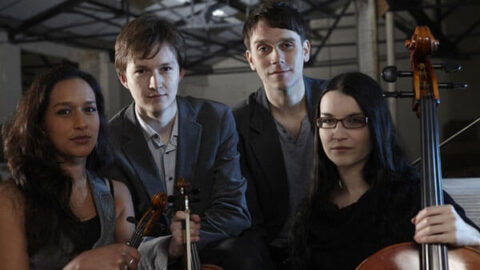To paraphrase Stravinsky, great composers don’t borrow, they steal. “Morphs and Magpies” was the theme of the Ligeti Quartet’s concert given at the Steiner Recital Hall in London on February 17, and the programme displayed some unrepentant thieves. This already much-praised British-based string quartet (Mandhira de Saram, violin 1; Patrick Dawkins, violin 2; Richard Jones, viola; Val Welbanks, cello) was founded in 2010. They have made their US debut, are in residence at a couple of UK universities and are supported by the City Music Foundation. Like the Kronos Quartet–their mentors and most obvious musical ancestors–they are contemporary music specialists interested in cross-genre collaborations, and this programme was an excellent showcase for their versatility.
It was perhaps not surprising that they began with György Ligeti’s first quartet (1952-4). Its subtitle “Métamorphoses nocturnes” suggested the “morph” theme would predominate, though really Ligeti had the soul of a thief and this piece is practically Bartók’s 7th Quartet. Its questioning winding lines, forceful reiterated gestures above a drone or loop, snap pizzicatos, and irregular rhythms like a skewed folkdance show one Hungarian composer unwittingly passing the baton to the next generation. The perfectly matched sonority of the Ligeti Quartet was immediately captivating: this is an ensemble who really listens to each other, and they judged the many mood shifts of this piece to perfection. Pushing the textural and sonic contrasts to the maximum, they stressed the modernity of Ligeti’s piece. I would love to hear them in his second quartet.
The Danish composer Gregers Brinch (b. 1964) was a new name to me, though his work has previously been heard at Steiner Hall. His String Quartet No. 1 was composed in 2001 and has been recorded, though this was its live premiere. The quartet’s violist stated Brinch’s work fits in the programme because it was composed at a transformative period in his life–when he decided to become a full-time musician–but in truth, it was the odd work out. The quartet did their best to invest this meandering four-movement tonally-inflected piece with character, though only in the slightly livelier finale did they have any success.
To say Tanya Tagaq’s work provided a contrast would be a huge understatement. She is a composer and Inuit throat singer; anyone who loves Mongolian or Tuvan overtone singing will discover that Inuit throat singing (katajjaq) is completely different. Tagaq demonstrates her unique, solo take on a style which is usually a dialogue between two women on this video. Her Sivunittinni (The Future Ones) was composed in 2016 for Kronos’ Fifty for the Future commissioning programme, which aims to expand the repertoire and provide teaching materials on contemporary quartet writing. Tagaq’s vocal recordings were arranged by Kronos regular collaborator Jacob Garchik.

It is stunning to hear what the human voice can do, and Sivunittinni translates these sounds to the string quartet. The score annotations include “Ice Groaning, slow and free” and “Sawing Through Bone–for Bone Marrow,” and the Ligeti Quartet were equal to all the challenges Tagaq threw at them. They scratched, growled, and swirled, reaching frenzied climaxes as if they’d morphed into a roused polar bear. The three young children sitting in front of me were enthralled; one boy announced afterwards “That was my favourite piece.”
The second half showed commonalities between two quartets written in the US and Soviet Union in the last years of the Cold War. John Zorn and Alfred Schnittke each in their own way embraced cartoon music, and one of my formative musical experiences was watching Tom and Jerry cartoons on TV: I was fascinated by the technicolour sounds, the funny onomatopoeic noises, and the sudden musical mood shifts within a 5-minute episode. (Later, as a nerdy student, I was delighted to discover that some Tom and Jerry episodes have touches of serialism in their soundtrack.) And on the other side of the Iron Curtain, Schnittke and his compatriot Sofia Gubaidulina wrote a lot of cartoon music, a truly polystylistic musical medium.
American composers including John Adams and Zorn have brought American cartoon musical style into the concert hall, typified by Zorn’s quartet Cat O’Nine Tails (1988). At one point Richard Jones, the charismatic viola player, stood up and mimed whipping gestures with his bow, reacted to sonically by the rest of the quartet. Mandhira de Saram led them through a crazy aural mosaic including Tea for Two and cheesy Americana. The piece is subtitled “Tex Avery Directs the Marquis de Sade,” though it was less 120 Days of Sodom, more Jerry whacks Tom over the head with a frying pan. But that’s not quite all, folks: the final chords, immaculately placed by the Ligeti Quartet, provided an unexpectedly sombre conclusion.

Schnittke’s music has been rarely heard in London concert halls since his death in 1998. He’s certainly a magpie in his String Quartet No. 3 (1983), using Lassus, Beethoven’s Grosse Fuge and Shostakovich’s DSCH cipher as source material. I am not a huge fan of his instrumental polystylism, but the Ligeti Quartet’s committed advocacy of his Third Quartet completely won me over. Against all odds, they projected a unified argument, and their fearless approach to spectral and vibrato-free sonorities proved ideally suited to Schnittke.
In a world crowded with excellent young string quartets, the Ligeti Quartet have more than superlative technique: they have a distinctive identity as promoters of late-20th century and new writing. They are currently collaborating with leading young British composers Christian Mason, Anna Meredith and Kate Whitley, and wherever composers want to take the string quartet in the 21st century, I am sure the Ligeti Quartet will be there with them.
























